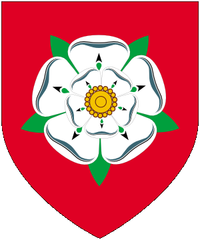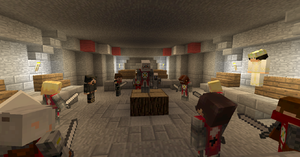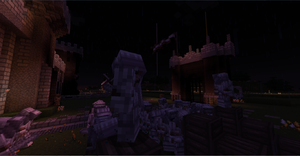Order of the White Rose
|
The Order of the White Rose was anything but old. They did not hold deep roots within Aegis, nor did they start back since the beginning of time. Starting first on the continent of Asulon, it had all began from the ideas of a commander known then as Peter Chivay, his brother Thomas, Baldir Voor & Velwyn Ashford and companions, and a willful hedge knight. Created was an Order that abided by the laws of the Church, all while protecting the sanctity of the Empire and the holiness of the Race of Man.
A name striking both pride and terror into the hearts of all races, in the Order's zenith, none could hope to stand against them. They were at once the Empire's sword and its shield. In the generations following its eventual disbandment, children would hear tales, stories of a force that declared war upon all the rest of the world, gaining the great enmity, in particular, of the Wood Elves of Malinor and the Uruks of Krugmar. It was also a name celebrated and viewed as the pinnacle of human might and valor, with the few remaining veterans and descendants of the White Rose becoming almost prodigies to the rest of the Empire.
At its zenith in the Kingdom of Kaedrin, an entity synonymous with the Rose, the Order was estimated to have hosted a force of roughly 50,000 soldiers, knights and brother-sergeants dedicated entirely to the will of God and the Emperor. Many of this number may have been lost during the Battle of the Dreadfort in 1412, in which the White Rose was prevalent.
Contents
The Rose's Beginnings
The Order's first holding was the Barony of Rivia, located just outside the County of Ildon. Its significance as the first official Order stronghold is always remembered with its members, and although simple in design and hardly defensible, the stronghold had a lasting and nostalgic effect on the Rose, and held significant importance to the Order's beginnings. Rivia is always remembered, and always praised. And with their Order firmly set in their first stronghold, they now sought to expand both their influence and their status within the Empire; and did so with massive recruitment, training, and military operations. It was this growing popularity and population that encouraged the Order to look for a newer, larger keep. One that would accommodate all the needs of this rapidly growing Order.
And so they looked to purchasing new land. Land unused in decades, and land perfect for the Order. This land was Ceru, the abandoned High Elf colony in the Duchy of the Holy Lands. Purchased from a fellow Rose and then the Lord Regent of Auvergne, Edmond Brunswick, the land was taken under ownership of the Order, and formally renamed Krak du Rhoswen, which stood for "Fortress of the White Rose". It was here that the Order really gained its renown, and started to develop an infamy that carried on with their actions. From firing lines of crossbows in Solace, to the burning of the heretical city known as Crestfall in the Holy Lands of Asulon, the White Rose had made a name for themselves; a name of both praise and hatred.
Battle Honors
First Harrenite Rebellion (1384)
The Siege of Ildon
Cleansing the Holy Lands
Extermination at Crestfall (c.1390)
The Battle of the Holy Lands (1398-1399)
Tarus Insurrection (1394)
The Sack of Phoenix Port
Jaruga War (1408)
The Battle of Podesta Fields
The Battle of Cintran
Imperial Invasion of Malinor (1408)
The Sack of Malinor
Hansetian-Blackmont War (1410-1415)
The Battle of Kralfield
The Battle of Florest
The Battle of Scrim
The Battle of Amedaius
The Siege of the Dreadfort
Blood Pact War (1418-1420)
The Battle of Colden
The Battle of the Crossing
The Fall of Asulon
"This Rose never wilts!"
As the final days of Asulon came, the White Rose was forced to leave their bastion of Krak du Rhoswen after long days of siege, and flee with the rest of the Empire east; away from the destruction of the entire continent.
Their landing in the dubbed land of Elysium did not prove a setback, but instead a new opportunity. Almost immediately did the Order establish a mighty war camp and set to gathering resources for a keep worthy to carry their name. This massive camp was surrounded by a moat of pikes with the heads and skulls of their Orcish, Malinorian and Adunian enemies impaled across them.
In Anthos, and the Kingdom of Kaedrin
"Ave, true to Kaedrin."
|
The Asulonians' time in the prism border-world of Elysium was relatively short and, aside from several great battles between the races therein, rather harmonious. Still, when passage to the new world of Anthos was discovered, the races wasted no time in traveling to it with great haste. Having bided their time in Elysium preparing the logistics for such an endeavor, the Holy Orenian Empire began to rapidly expand all along from their heartland in the northeast of the great Anthosian plane, in particular to the West, further pushing away the Elven border. Initially, the Order of the White Rose was granted a castle within the Imperial capital at Abresi, where they thrived and assisted in upholding the laws and sanctity of Empire and Church. This castle, however, proved some a restriction to the Order's effectiveness, as it had grown vastly in manpower and prestige since the days of Rivia. Seeing this and seeing it well, the Emperor Godfrey I shortly after created the Kingdom of Kaedrin from the Duchy of the Westerlands along the Malinorian border, and granted it to then Grandmaster of the Order, Peter Chivay, whose family was thereafter considered a royal house within the Empire. When Peter Chivay ascended to the Kingship of Kaedrin, the title of Grandmaster passed to the King's younger brother, Thomas Chivay, and eventually to Edmond Brunswick after a series of other grandmasters.
The foundations of a mighty fortress, the prospective capital of Kaedrin and with all certainty an eventual human military capital, were laid over and constructed over the process of several years. This fortress was Ard Kerrack, with walls, moats, a defensive structure, and a rather notorious checkpoint system known for its discrimination of foreigners making a siege of the place impossible. Not once was Ard Kerrack taken by an enemy force while the Order of the White Rose still occupied it.
|
From Ard Kerrack was launched a vast multitude of the Empire's most successful campaigns and wars in all its history, amongst them most famously the Malinorian Crusades and the Battle of the Dreadfort against the rebellious Teutonic forces of Hanseti. One of the strongest fortresses ever constructed in the history of man, aspiring architects and engineers today still study Ard Kerrack's wall plans and defenses. The fortress's chief architects were Chet Silsbury and Arkus Ferrier.
As it was a synonymous regime of the Order of the White Rose, Kaedrin had no real levy force, with the Rose serving as its defenders and its warriors; the countrymen of Kaedrin were the Order's main source of recruits and general manpower. A privy council oversaw the domestic, military and economic affairs of the kingdom. This consisted of active White Rose officers skilled prior in the capacity in which they would serve. The last and most famous of Kaedrin's privy council is as follows:
Prince Thomas Chivay †, Lord Steward
Vibius 'the Elder' de Sola †, Lord Chancellor (not to be confused with his son, the later Imperial Marshal)
Baldir Toov †, Lord Marshal
Bran Volsung †, Lord Justiciar
Alexei Nicodemus †, Lord Chamberlain
Roland Ashford †, Lord Archbishop
Hadrien de Sarkozy was also long-serving as Lord Chancellor of Kaedrin and is credited with many of the kingdom's diplomatic and political achievements. It is no surprise that his success and ambition as a statesman led to his being sainted some time after his death.
White Rose Salute
The White Rose was also known far and wide by its iconic salute, known also as the Kaedreni salute, where one stands at attention, presses their right fist to their heart, then extends it outward. "Ave, true to Kaedrin" or "Ave Chivay" were commonly stated immediately after this. Later, the Kaedreni salute would be adopted into use by the Imperial Army of the Third Empire.
The Order's Disbandment
"Malinor delenda est!"
A compilation of diplomatic crises and the death of Godfrey I of Horen resulted in the eventual Disbandment of the Order of the White Rose, signed by the Order's final Grandmaster, Edmond Brunswick, around the year of 1420. Ensuing was a momentous collapse of the First Empire, many of its proponents - amongst them Kaedreni leadership - embarking on an Exodus to the distant land of Aeldin, only to return in Anthos' final moments, perhaps to avoid entrapment and the devastation of the fire and storms destroying the lands abroad.
This was not the end of the former Order's surviving members, who would later return from their self-imposed exile to reunite the defaced crown of Oren and reform it into the Third Orenian Empire under the Imperial House of Chivay.


